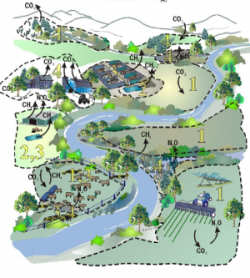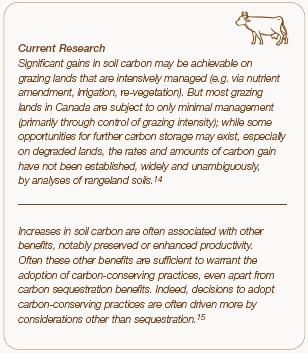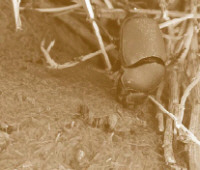



Cow/Calf Operations and Greenhouse Gases.
By N. Lee Pengilly, Alberta Agriculture and Food. Gratefully aknowledged in the assistance of the production of this book are Agriculture and Agri-Food Canada, Alberta Environment, Western Forage and Beef Group, Canadian Cattlemen’s Association, The Greenhouse Gas Mitigation Program for Canadian Agriculture.A new booklet Cow/Calf Operations and Greenhouse Gases will help cow/calf producers understand greenhouse gas (GHG) emissions and how modifying some aspects of their operations and implementing certain beneficial management practices can help reduce GHG.
“This booklet explains various management strategies associated with the reduction of GHG from the atmosphere, particularly on cow/calf herd health, grazing management, feed management and manure management,” says Kerrianne Koehler-Munro, climate change program planner with Alberta Agriculture and Food, Edmonton.
Integrated agroecosystem
|

|
Producers who already incorporate some beneficial management practices in their operations will find information that can help them improve what they are already doing as well as learning about new management practices that reduce GHGs. For example, feeding high quality feed and balanced rations creates an environment in a ruminant’s digestive system that is not conducive to methane producing fermenters.
“It is imperative that producers have this information,” says Koehler-Munro. “The Alberta government is taking proactive steps in addressing environmental sustainability and GHG emissions. For example, the government is now regulating large emitters of GHG.”
Cow/calf producers have the potential to sequester a great deal of carbon. According to the 2001 Agriculture Census data, Alberta’s livestock and forage systems sequestered 13.8 to 14.2 metric tonnes of carbon dioxide equivalent (CO2e) more than they emitted. However, the beef sector is responsible for 92 per cent of Alberta’s livestock GHG emissions, that being primarily methane.
“Basically, the reduction of GHG within an operation protects the environment, improves production efficiencies and increases potential for return on the investment,” adds Koehler-Munro. “The booklet also provides contacts and resources that producers can access for more information and guidance on reducing GHG.”
How Can the Cow/Calf Sector Help to Address Greenhouse Gas Emissions?
In general, implementing certain management practices can address greenhouse gas emissions in the agricultural sector. The strategies involve management practices that would:- Reduce emissions (e.g. improve feeding efficiency or manure management)
- Remove emissions (e.g. increase carbon in soils, pastures or trees)
- Replace fossil fuels (e.g. use renewable energy)

Opportunities exist for the beef sector to be a significant part of the greenhouse gas solution in agriculture and research is ongoing to determine the best methods to do this. In the meantime, a number of common sense approaches can be taken that both improve efficiency and minimize greenhouse gas emissions. In addition to reducing greenhouse gas emissions, the cattle industry is an integral component of the forage and rangelands that sequester carbon through photosynthesis, a natural process involving the uptake and storage of carbon carried out by both plants and trees during the growing season. According to the 2001 Agricultural Census carried out by Statistics Canada, there were 10.72 million hectares of such lands in Alberta:
- 1.98 million hectares of tame pasture
- 2.06 million hectares of hayland
- 6.68 million hectares of rangeland6 It is estimated that:
- tame pasture may sequester 1.10 tonnes of carbon per hectare per year
- hayland may sequester 0.9 tonnes of carbon per hectare per year
- rangeland may sequester 0.35 tonnes of carbon per hectare per year7
Grazing Management
Greenhouse Gas Benefit
According to Beneficial Management Practices: Environmental Manual for Alberta Cow/Calf Producers, grazing management is the care and use of range and pasture to obtain the highest sustainable yield of animal products without endangering forage plants, soil, water resources and other important land attributes. Accomplishing these goals require maintaining an adequate leaf area on desirable plants in order to intercept the sunlight on which photosynthesis depends. Animal grazing must also be controlled so that plant vigour is maintained, and water and nutrient cycles are enhanced. Grazing systems that control where and for how long the cattle graze, result in healthier pastures, higher productivity and potentially, a longer grazing season. Given the number of acres dedicated to livestock grazing in Alberta, improvements in grazing management could have a positive impact on provincial soil carbon sequestration while contributing to improved production and profitability.
Encourage healthy populations of beneficial insects that breakdown manure
Greenhouse Gas Benefit
Dung pats that have not broken down represent a loss of soil nitrogen as well as grazing area. When the dung is incorporated back into the soil, the nitrogen is available for plant growth rather than volatilized into the atmosphere in the form of nitrous oxide and carbon dioxide. Although several other factors play a role in pat degradation (e.g. foraging by birds, trampling by cattle, frost, rain and vegetation), insects are important components of the recycling process.50 Benefits of manure breakdown include:
- nutrient recycling including significant amounts of nitrogen
- increased grazing and forage production
- soil aeration, water retention, root penetration and reduction of run-off
- reduced pest flies and parasitism
- reduced disease
- cost savings
To encourage healthy populations of beneficial insects, choose agricultural and animal health products recognized to be safe for dung inhabiting insects and determine the safest time of year to apply them.
This booklet can be downloaded as a whole here (pdf file size 6 MB), or by section.Contents
Introduction Part 1 (pdf file size 165 KB)Introduction Part 2 (pdf file size 149 KB)
Figure 1 - Farm GHG Sources and Sinks (pdf file 385 KB)
Section 1 Herd Health (pdf file size 88 KB)
Section 2 Grazing Management (pdf file size 1,376 KB)
Section 3 Feed Management (pdf file size 109 KB)
Section 4 Manure Management (pdf file size 355 KB)
References (pdf file size 40 KB)
April 2007


